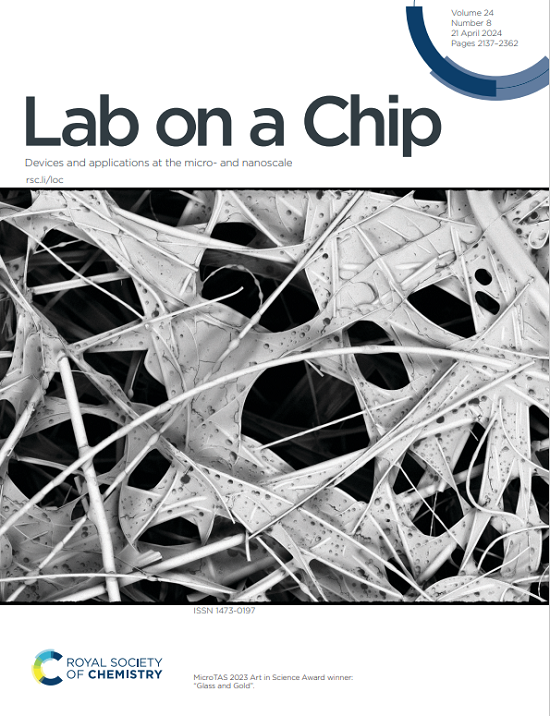微滴微流体与机器学习的结合揭示了脂肪来源的干细胞如何调节雌激素受体阳性乳腺癌的内分泌反应和肿瘤异质性
IF 6.1
2区 工程技术
Q1 BIOCHEMICAL RESEARCH METHODS
引用次数: 0
摘要
大约70%的乳腺癌(BC)诊断为雌激素受体阳性(ER+),约40%的ER+ BC患者对内分泌治疗(ET)出现新抗性。最近的研究发现肿瘤微环境(TME)在内分泌抵抗中起关键作用,其中脂肪源性干细胞(ASCs)在癌症进展中起重要作用。大多数关于ASC-BC相声的研究依赖于二维(2D)培养系统或使用不能复制三维(3D)环境复杂性的条件介质。本研究使用微流控液滴捕获阵列和巯基丙烯酸酯(TA)水凝胶支架,将ER+ BC细胞和ASCs作为单独的3D球体(单培养)或类器官(共培养)在单个装置中共培养。通过评估选择性雌激素受体降解剂(SERD)富维司汀(ICI 182780)和17β-雌二醇(E2)治疗后的增殖情况,研究了球体和类器官的内分泌反应。对增殖标志物(Ki67)进行终末免疫染色,以评估来自不同供体背景(年龄和BMI)的ASCs的存在如何调节内分泌反应。结果表明,即使在ICI存在的情况下,含有两种模型ER+细胞系(MCF7和ZR-75)的类器官也表现出增强的Ki67表达,这表明ASCs在癌症进展和内分泌抵抗中发挥了作用。采用数据聚类和分类算法,基于Ki67表达和球体面积对细胞行为进行分类,以识别Ki67高(H)、中(I)和低(L)表达的不同簇。机器学习进一步将数据分层,揭示了ASCs对Ki67表达的直接影响,以及供体特异性特征如何影响asc驱动的TME变化。值得注意的是,来自年龄较大、BMI较低的供者(>50)的ASCs即使在内分泌治疗的情况下也能增强Ki67的表达,而年轻的供者(<40)在没有ICI和E2的情况下也能显著增强Ki67的表达。总之,本研究证明了一种仿生培养系统的实用性/发展,该系统通过癌细胞与ASCs的共培养来重建异质3D ER+肿瘤。该系统提供了对控制ER+乳腺癌异质性和对内分泌治疗反应的细胞外因素的深入了解。本文章由计算机程序翻译,如有差异,请以英文原文为准。
Droplet microfluidics integrated with machine learning reveals how adipose-derived stem cells modulate endocrine response and tumor heterogeneity in ER+ breast cancer
Approximately 70% of breast cancer (BC) diagnoses are estrogen receptor positive (ER+) with ~40% of ER+ BC patients presenting de novo resistance to endocrine therapy (ET). Recent studies identify the tumor microenvironment (TME) as having a key role in endocrine resistance in which adipose-derived stem cells (ASCs) play an essential role in cancer progression. Most studies on ASC-BC crosstalk rely on two-dimensional (2D) culture systems or use conditioned media that cannot replicate the complexity of the three-dimensional (3D) environment. This study used a microfluidic droplet trapping array and thiol-acrylate (TA) hydrogel scaffold to co-culture ER+ BC cells and ASCs as individual 3D spheroids (single culture) or organoids (co-culture) in a single device. Endocrine response was interrogated in both spheroids and organoids through the evaluation of proliferation following treatment with the selective estrogen receptor degrader (SERD) Fulvestrant (ICI 182,780) followed by 17β-estradiol (E2). Terminal immunostaining for the proliferation marker (Ki67) was performed to evaluate how the presence of ASCs from different donor backgrounds (age and BMI) can modulate endocrine response. Results demonstrated that organoids containing two model ER+ cell lines (MCF7 and ZR-75) exhibited enhanced Ki67 expression even in the presence of ICI, suggesting a role for ASCs in cancer progression and endocrine resistance. Data clustering and classification algorithms were employed to categorize cellular behavior based on Ki67 expression and spheroid area to identify distinct clusters with high (H), intermediate (I), and low (L) Ki67 expression. Machine learning further stratified the data and revealed the direct effects of ASCs on Ki67 expression as well as how donor-specific features influenced ASC-driven changes in the TME. Notably, ASCs from an aged donor (>50) with lower BMI (<30) were able to enhance Ki67 expression even in the presence of endocrine therapy, while younger (<40) donors substantially enhanced Ki67 expression in the absence of both ICI and E2. Together, this study demonstrates the utility/development of a biomimetic culture system that recreates heterogenic 3D ER+ tumors through the co-culture of cancer cells with ASCs. This system provided insight into cell-extrinsic factors that govern ER+ breast cancer heterogeneity and response to endocrine therapy can be gained.
求助全文
通过发布文献求助,成功后即可免费获取论文全文。
去求助
来源期刊

Lab on a Chip
工程技术-化学综合
CiteScore
11.10
自引率
8.20%
发文量
434
审稿时长
2.6 months
期刊介绍:
Lab on a Chip is the premiere journal that publishes cutting-edge research in the field of miniaturization. By their very nature, microfluidic/nanofluidic/miniaturized systems are at the intersection of disciplines, spanning fundamental research to high-end application, which is reflected by the broad readership of the journal. Lab on a Chip publishes two types of papers on original research: full-length research papers and communications. Papers should demonstrate innovations, which can come from technical advancements or applications addressing pressing needs in globally important areas. The journal also publishes Comments, Reviews, and Perspectives.
 求助内容:
求助内容: 应助结果提醒方式:
应助结果提醒方式:


